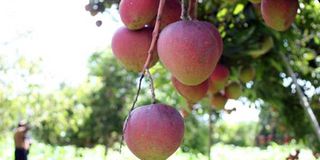Kenya sets sights on EU market for its mangoes

Mangoes growing in a farm. Kenya is eyeing the lucrative European Union market for its mangoes as efforts to improve quality of the produce begin bearing fruits. FILE PHOTO | NATION MEDIA GROUP
What you need to know:
- The European Union (EU) in 2014 announced that it would inject Sh1.4 billion ($16.1 million) to help improve Kenya’s food security through the horticultural, dairy, apiculture, aquaculture sectors.
Kenya is eyeing the lucrative European Union market for its mangoes as efforts to improve quality of the produce begin bearing fruits.
Kenya Plant Inspectorate Health Service (Kephis) Managing Director Esther Kimani said the agency introduced self-regulatory measures in August 2014 to ensure production of quality mangoes in a bid to access the export market.
“The International Standards for Phytosanitary Measures (ISPM) no. 26 allows for the creation of pest-free areas to control the fruit flies in some region. We have managed to reduce the pests by 80 per cent and we hope that soon those mangoes will access the European market,” she added.
The European Union (EU) in 2014 announced that it would inject Sh1.4 billion ($16.1 million) to help improve Kenya’s food security through the horticultural, dairy, apiculture, aquaculture sectors. Among other things, EU would help in ensuring that the farm produce meet some of its most stringent standards.
A recent survey conducted in several farms in mango growing areas by Kephis shows there has been a drastic reduction of flies following distribution of more than 6,000 pheromone traps in Elgeyo-Marakwet County alone, with data indicating that great strides have been made in improving the quality of farm produce.
Horticulture produce which includes fruits, vegetables and rose flowers, earns an estimated Sh100 billion annually in the EU market, and this is expected to rise with the addition of mangoes into the export basket.
Mr Francis Kiplagat, a large scale mango grower in Kerio Valley said farmers can now smile as efforts to improve quality are paying off.
“The number of fruits that were attacked by these flies resulted to rotting of the produce. We used to harvest 12-15 fruits per tree but this is no longer the case as we are now harvesting 400-500 fruits in a single season,” said Mr Kiplagat, 68, who grows various varieties of mangoes on his 50-acre farm.
The farmer adds that he used to catch up to 600 flies when the interventions were introduced but this is no longer the case with him and farmers in the valley.
Kephis Kitale’s regional manager Alfred Musuya, concurs that farmers have not accessed the EU market due to pests and the fruit flies.
He said there is now hope that the menace would be rooted out through a three-year project funded by the EU.
Dubbed Standards and Market Access Program (SMAP), the project is implemented by the United Nations Industrial Development Program (UNIDO) with among other partners, Kephis, Kenya Bureau of Standards and Kenya Directorate of Veterinary Services (KDVS) in 2014.
Mr Musuya said efforts are being intensified to create pest-free areas through buffer zones.
Spread of the flies
“It is important to have the farmers surrounding the core farms sensitised to prevent spread of the flies. We have done this in areas such as Sambalach, Koimur and Kabarak where farmers have been educated on integrated pest management,” he said.
Elyeyo-Marakwet County Executive in charge of Agriculture Mr Shadrack Yatich noted that the county has a huge potential for mango production.
He said through an ambitious subsidy programme, the county has distributed more than 15,000 improved varieties of mango seedlings to farmers to boost production.




